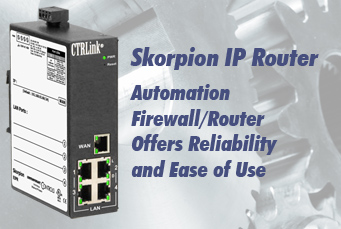Control Network Newsletter

New Skorpion IP Router Receives Customer Requested Features
 April 2011 - Contemporary Controls provided several key customers beta versions of the EIPR Skorpion IP Router. The EIPR links two Internet Protocol (IPv4) networks together – passing appropriate traffic while blocking all other traffic. The feedback has been positive. Customers liked the simple layout, the simple web page configuration with on-line help, and the built-in four-port 10/100 Mbps Ethernet switch on the LAN-side. It had all the features they were expecting – Port Address Translation (PAT), Network Address Translation (NAT) and Port Forwarding. The unit has a Dynamic Host Configuration Protocol (DHCP) server on the LAN-side, a DHCP client on the WAN-side, and a stateful firewall. However, there were some features that our customers felt would make the EIPR a better product and we heeded their advice. The following features will be added to firmware version 1.3.0.
April 2011 - Contemporary Controls provided several key customers beta versions of the EIPR Skorpion IP Router. The EIPR links two Internet Protocol (IPv4) networks together – passing appropriate traffic while blocking all other traffic. The feedback has been positive. Customers liked the simple layout, the simple web page configuration with on-line help, and the built-in four-port 10/100 Mbps Ethernet switch on the LAN-side. It had all the features they were expecting – Port Address Translation (PAT), Network Address Translation (NAT) and Port Forwarding. The unit has a Dynamic Host Configuration Protocol (DHCP) server on the LAN-side, a DHCP client on the WAN-side, and a stateful firewall. However, there were some features that our customers felt would make the EIPR a better product and we heeded their advice. The following features will be added to firmware version 1.3.0.
Firewall Disable – By default the firewall is enabled for security reasons preventing WAN-side requests to pass through the router. This is vitally important when connecting an IP router to the Internet. However, in secure internal internetworks where subnet-subnet routing is required, the firewall becomes a headache so a feature has been added in the router setup to disable the firewall. With the firewall disabled, the EIPR becomes a simple LAN-LAN router instead of a LAN-WAN router.
Increased NAT Entries – Network Address Translation provides a one-to-one translation of LAN-side IP-addresses to WAN-side IP-addresses requiring that each IP-pair needs to be entered into a table. Currently, there is room for five entries and we have been requested to increase the entries to ten. NAT should not be confused with PAT. Port Address Translation is built-in to the EIPR allowing several LAN-side connected computers access to the Internet using only one public IP address by changing port assignments. NAT does not change port numbers but instead provides a one-to-one mapping of private to public addresses.
Remote Access – Configuring the EIPR is accomplished using a web browser attached to one of the LAN-side ports. However, we have been requested to allow configuration to be accomplished from the WAN-side when there is no competent staff available to configure the IP router where it is located. Allowing for remote access creates a security risk so care was taken in providing this feature. First, the IP router must be initially configured for remote access because this is not the default state. During initial configuration, an option is provided that allows the selection of an alternate port number when accessing the IP router from the WAN-side. The default port number is 80 but it is possible to select an alternate port such as 8080 when accessing the IP router. Once the IP router is reached, standard authentication is used to gain access to the configuration screens.
Port Forwarding Ranges – Port Forwarding allows WAN-side requests to pierce the firewall thereby allowing LAN-side devices such as web servers to be accessible by WAN-side web browsers. Currently, up to ten port forwarding assignments can be made but some devices have a range of sequential port numbers that must be opened. To do this for each port assignment is tedious while running the risk that there will be insufficient space for entries. Instead, there will be ten additional entries that allow for port address ranges.
A video is available to introduce the Skorpion IP Router and explain how the Skorpion IP Router can be used to link two Internet Protocol (IPv4) networks together – passing appropriate traffic while blocking all other traffic. Watch the video or visit the EIPR Skorpion IP Router product page to learn more.